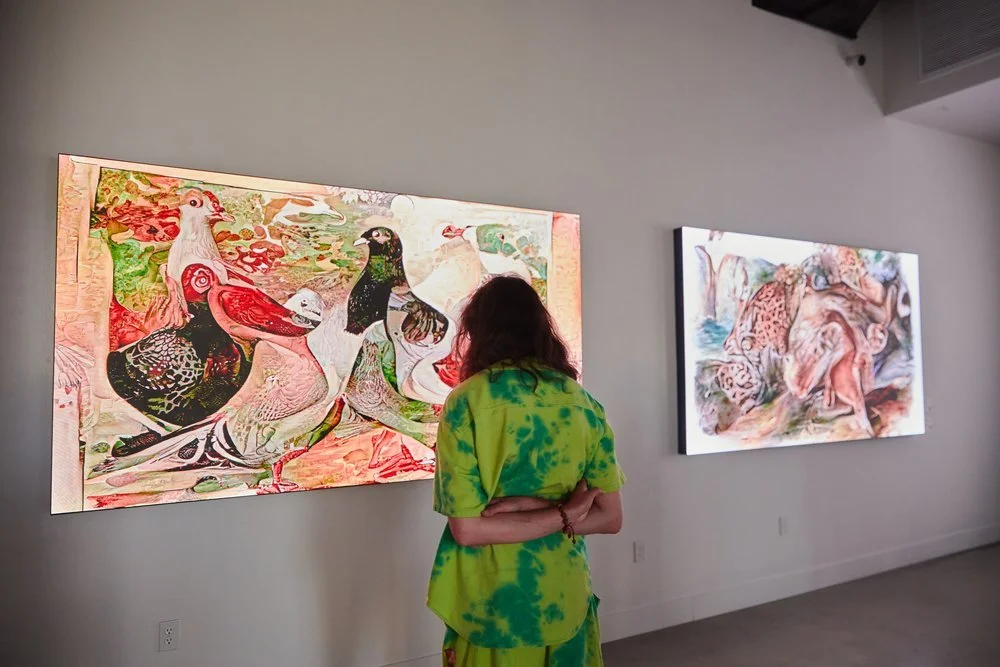CyberZoo
Cyberzoo, a Netart work created in 2003 by multimedia Argentinian artist Gustavo Romano, a pioneer in Digital Art in Latin America and active contributor. The piece explores the intersection between artificial and biological life, drawing parallels between the spread of viruses and the dissemination of ideas. The artwork prompts reflection on the fluidity of identity in the digital age, where the boundaries between collective and individual selves become increasingly blurred.
The artist web design decisions adapted to the limitation of the internet in Latin America at the time and the socio-economic and cultural context of the region. At the time most people didn’t have internet connection at their homes and if they had access, the bandwidth and speed weren’t ideal. Net art was growing in Latin America but wasn’t as supported as in North America or Europe influencing the artist decision of creating the Cyberzoo in both Spanish and English. Today web browsers automatically translate the content in most websites, in the early 2000’s that wasn’t and option, that’s why the first encounter with the Cyberzoo gives the audience the option to decide in which language experience the Netart.
Cyberzoo 2024
The Cyberzoo is contained within a website with a basic web design for the time, but for most efficiency. Romano’s uses vibrant yellow, green, and red colors to create a sense of toxicity and contamination, reinforced by a biohazard sign. The Cyberzoo invites exploration through six distinct sections, each encapsulated within labeled rectangles, mirroring those found in traditional organization websites like information, principles, values, and a store. The main part of the Cyberzoo is a tour section where visitors can observe viruses from the late 90s, confined within the Cyberzoo without risking infection.
In a thought-provoking twist, Romano treats viruses as endangered species worthy of conservation, envisioning a cyber zoo as their sanctuary. The audience is encouraged to participate in the growth of this digital wildlife by sending postcards with attached viruses. One can contribute to the conservation intents by shopping a souvenir or becoming a member.
In the physical exhibition of the piece, the room is painted with the distinct bright yellow, and flat computer screens, keyboards, and mice are available for the audience to interact with the artwork. Flat screens in the yellow walls display some of the viruses, which were mostly beautiful bit-image creations with playful interactions and text that can be compared with net art pieces for their ingenuity and critical content. To support the concept, the artist uses banners with relevant information that adds context to the piece. Romano's attempt at conservation is poetic and ironic, a characteristic of the author, who often uses irony to talk about deeper issues. The Cyberzoo was created before social media became popular, my space was the predominant social space and messenger the main communication outlet. The exploration of viral, makes the author a visionary of what this would mean and how this would revolution our life’s, the way we communicate, how we shop, and more deeply how we develop our identities.
The artwork highlights the complex interplay between offline and online realities, shaping identities and perceptions, blurring the line between the digital and biological world. The artwork also points out how technology endangers biological and artificial life, making conservation efforts even more crucial.
Sources
“El Arte Digital En Colombia, Una Mirada En Contexto by Trucodisponible - Issuu.” 2019. Issuu.com. June 7, 2019. https://issuu.com/trucodisponible/docs/articulo_artes_digitales_en_colombi
“Hello World VIRTUAL CUBE.” n.d. Helloworld.4rt.eu. Accessed June 6, 2024. https://helloworld.4rt.eu/vcube/index.html
icons8. 2022. “What Was the Internet of the Early 2000s.” Blog.icons8.com. July 7, 2022. https://blog.icons8.com/articles/what-was-the-internet-of-the-early-2000s/
Regine. 2004. “The First Zoo Dedicated to Artificial Life.” We Make Money Not Art. December 31, 2004. https://we-make-money-not-art.com/the_first_zoo_d/
“Remember 2006? How the Internet Has Changed in the Past Five Years.” 2011. Changing Journalism. August 15, 2011. https://grovesprof.wordpress.com/2011/08/15/remember-2006-how-the-internet-has-changed-in-the-past-five-years/
Romano, Gustavo. n.d. “Gustavo Romano.” Gustavo Romano. Accessed June 6, 2024. https://www.gustavoromano.org/portfolio/cyberzoo-en.htm
Romano, Gustavo . 2003. “CyberZoo | the First Zoo Dedicated to the Artificial Life.” Www.cyberzoo.org. 2003. https://www.cyberzoo.org/eng/HOME.HTM
“Web Development Evolution from the 2000s’ to 2020.” 2020. Jellyfish.tech. February 17, 2020. https://jellyfish.tech/blog/web-development-evolution-from-2000s-to-2020/








